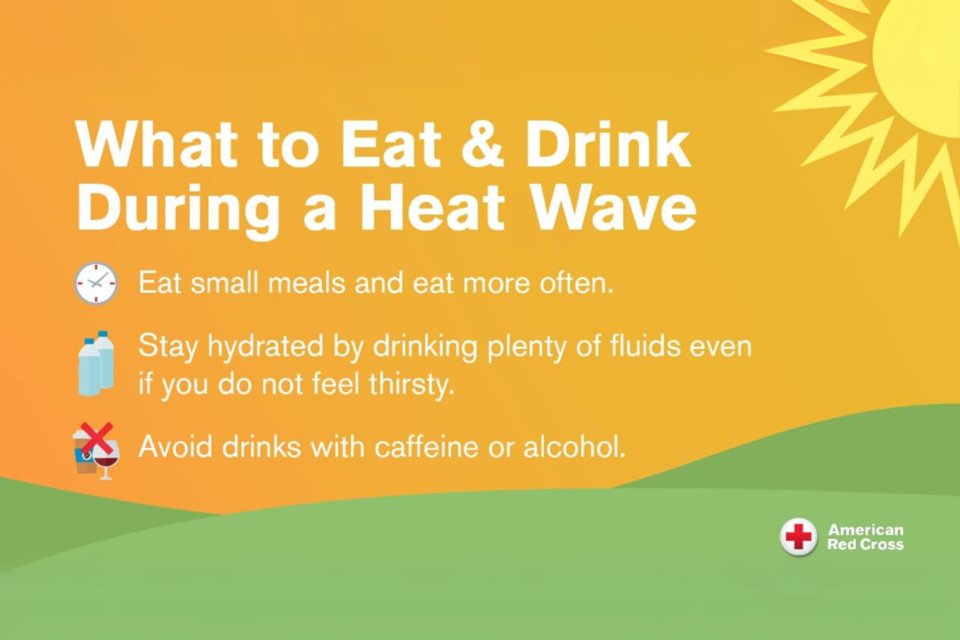With experts predicting a hotter-than-normal summer across much of the country, it’s important to not overlook this invisible danger. Such extreme heat can be dangerous ─ even deadly ─ and the American Red Cross urges everyone to take these three critical steps:
- Stay hydrated by drinking a cup of water every hour, even if you don’t feel thirsty. Avoid sugary, caffeinated and alcoholic drinks.
- Stay cool by spending time in air-conditioned places. If your home is too hot, go to a mall, library or cooling center.
- Stay connected by checking on others and asking for help if you need it. Make sure pets have access to fresh water and shade.
WHAT YOU SHOULD DO
Look out for loved ones and neighbors during extreme heat ─ send a text, make a call or knock on their door. Especially at risk are older adults, children, pregnant women, people with chronic conditions or disabilities, outdoor workers, athletes and people without air conditioning.
Remind everyone to drink water, even if they don’t feel thirsty. Encourage them to avoid sugary, caffeinated or alcoholic drinks. Babies should be breast-fed or bottle-fed often. Fewer wet diapers or darker urine can be signs of dehydration. Encourage athletes and outdoor workers to take breaks in the shade. They should drink a cup of water every 20 minutes and take frequent water breaks.
Help those without air conditioning find a safe place to go like a mall, library or cooling center. They can sit in the shade outside or take cool showers or baths to help cool off. Remind people to wear lightweight, loose-fitting clothes in light colors.
Never leave a child or pet alone inside a parked car, and make sure pets have access to fresh water and shade.
HEAT ILLNESS
It’s critical to act fast if someone has become ill because of the heat.
- Heat cramps are signaled by heavy sweating and muscle pain. Have the person stop what they’re doing, rest in a cool place and slowly sip water. If they feel sick, don’t give them anything to drink and get medical help if cramps last over an hour or they have heart problems.
- Heat exhaustion is signaled by heavy sweating, weakness, cool and clammy skin, muscle cramps, dizziness, fainting, nausea or vomiting. Have the person stop what they’re doing, rest in a cool place and slowly sip water. If they feel sick, don’t give them anything to drink. Loosen their clothes and place cool wet cloth on their body. Get medical help if they don’t feel better, vomit or have heart problems.
- Heat stroke is a deadly condition signaled by high body temperature, rapid heartbeat, confusion, headache, dizziness, fainting, nausea or vomiting. Call 911. Move the person to a cool place, remove extra clothing and use a wet cloth or a cool bath to cool down. Don’t give them anything to drink.
IF THE POWER GOES OUT
When a heat wave and a power outage happen at the same time, it can be even more dangerous. Stay in air conditioning either at home or at a mall, library or cooling center. If you need to keep medicine cold or use medical devices that need power, talk to your doctor about a backup plan. Keep an ice-filled cooler stocked with food, water and medicine, so that they don’t spoil. More information is available here.
Finally, download the free Red Cross First Aid app so you’ll know what to do if emergency help is delayed and the free Emergency app for real-time weather alerts and heat safety information. Content is available in English and Spanish with an easy-to-find language selector. Find both apps in smartphone app stores by searching for the American Red Cross or going to redcross.org/apps.
CLIMATE CRISIS
As part of a years-long trend, extreme heat is happening more often, lasting longer and becoming more intense. Heat Action Day 2025 is on June 2, 2025, a global event hosted by the International Federation of Red Cross and Red Crescent Societies (IFRC).
Alongside the global Red Cross and Red Crescent network, the American Red Cross is helping to keep communities safe and prepared as extreme heat events become more common. The American Red Cross supports climate programming in 14 countries across Asia, the Pacific and Latin America, and hosts the main resource library on extreme heat risks and action, as well as the Heat Toolkit. This toolkit is used across the globe to help develop Heat Action Plans that protect and prepare vulnerable communities from extreme heat events with simple, low-cost actions. With the Red Cross Climate Center, the American Red Cross has conducted evidence-building research to better understand the impacts of heatwaves on low- and middle-income countries and uses that information to help develop effective national heat messaging and risk communications.
With the support of the Rockefeller Foundation, the American Red Cross, together with the Red Cross Climate Center, Bangladesh Red Crescent Society and Nepal Red Cross Society, are working together to better understand public perceptions of heat action plans, as well as the role that local governments can take to support emergency preparedness and keeping people safe in the face of emergency.




